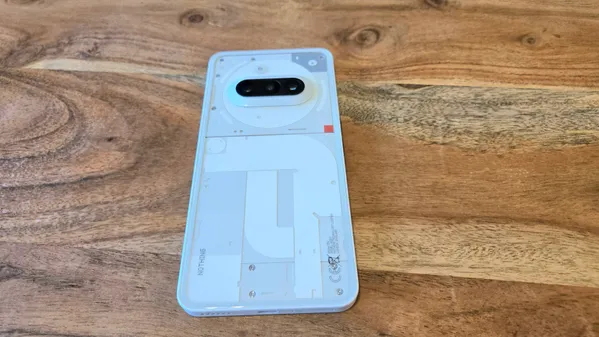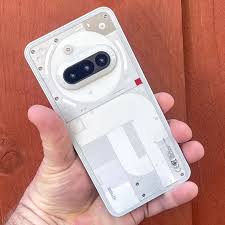Nothing Phone (3) Review: A Bold and Unique Contender in the Flagship Arena
Priced at $799, the Nothing Phone (3) represents the company’s most ambitious release to date, stepping confidently into the flagship smartphone category. With its distinctive design, enhanced camera system, innovative Glyph Interface, and competitive performance, it aims to challenge established players like the Apple iPhone 16 and Samsung Galaxy S25. While it lacks some premium features like mm Wave 5G and advanced AI integration, it offers a refreshing alternative for users seeking something different. Nothing Phone (3) Review: A Bold and Unique Contender in the Flagship Arena
Design and Build Quality
The Nothing Phone (3) features a recognizable transparent design with a clear glass back that reveals internal components like a semi-circular ribbon cable, flash module, and red accent square. Its 100% recycled aluminum frame feels robust and well-constructed, with smooth transitions between materials.
Measuring 6.32 x 2.98 x 0.35 inches and weighing 7.69 ounces, it is larger and heavier than many competitors. For comparison:
- iPhone 16: 5.81 x 2.82 x 0.31 inches, 6.0 ounces
- Galaxy S25: 5.78 x 2.78 x 0.28 inches, 5.71 ounces
The front is dominated by a 6.67-inch AMOLED display with slim bezels, a small punch-hole selfie camera, and an under-display fingerprint sensor. The phone is IP68-rated for dust and water resistance and comes with a soft clear case in the box. Color options include Black and White.
Glyph Interface: Lighting and Interaction
A standout feature is the Glyph Matrix, a circular array of 489 micro-LEDs on the back that replaces previous multi-zone LED designs. It displays notifications, time, battery status, and visualizations for music/recordings. A new Glyph Button below the LED ring lets users cycle through “Glyph Toys” like a clock, stopwatch, or even a spin-the-bottle game. While fun and distinctive, these features are optional and can be disabled.

Display
The Phone (3) boasts a 6.67-inch AMOLED screen with:
- Resolution: 2,800 x 1,260 pixels
- Refresh Rate: 1–120Hz adaptive
- Peak Brightness: 4,500 nits (800 nits typical)
This display is larger, brighter, and smoother than the 60Hz iPhone 16 and matches the Galaxy S25’s 120Hz refresh rate. It offers excellent visibility indoors and outdoors.
Performance and Hardware
Powered by the Snapdragon 8s Gen 4 chip, the Phone (3) comes in two configurations:
- 12GB RAM + 256GB storage ($799)
- 16GB RAM + 512GB storage ($899)
In benchmarks:
- Geekbench 6: 2,208 (single-core), 7,002 (multi-core)
- PCMark Work 3.0: 13,435
- GFXBench Aztec Ruins: 60fps
It performs well in daily use and handles games like Genshin Impact smoothly at high settings, though it falls short of the Galaxy S25 in raw power. Real-world performance is snappy and responsive.
Battery and Charging
The 5,150mAh battery offers:
- 15 hours of video playback (100% brightness)
- 65W wired charging (32% in 15 min, 100% in 70 min)
- 15W wireless charging
- Reverse charging support (7.5W wired, 5W wireless)
Battery life exceeds the Galaxy S25 (14h 15m) but trails the iPhone 16 (17h 47m).
Connectivity
The Phone (3) supports:
- 5G (sub-6GHz and C-band, no mmWave)
- Wi-Fi 7
- Bluetooth 6.0
- Dual nano-SIM + eSIM
In speed tests on T-Mobile’s network, it reached 378Mbps download and 22.5Mbps upload. Wi-Fi 6 performance was solid but not class-leading.
Cameras
Nothing’s best camera system to date includes:
- 50MP main camera (f/1.68, OIS)
- 50MP telephoto camera (f/2.68, 3x optical zoom, OIS)
- 50MP ultra-wide camera (f/2.2, 114° FoV)
- 50MP front camera (f/2.2)
Photos show accurate colors, good detail, and improved dynamic range. The telephoto supports AI-assisted zoom up to 60x, and macro shots are impressive. Video recording tops out at 4K/60fps with reliable stabilization (except on the selfie camera). Portrait mode handles challenging subjects (like glasses) better than many rivals.
Software and AI
The phone runs Android 15 with Nothing OS 3.5, offering:
- Custom dot-matrix widgets and monochromatic theme options
- Essential Space app for notes, screenshots, and recordings (no cloud sync)
- Essential Key (dedicated button) for quick access to recordings and screenshots
- 5 years of OS updates and 7 years of security patches
Notably, it lacks built-in AI features—users must rely on third-party apps like Google Gemini for AI functionality.
Audio and Call Quality
The stereo speakers (earpiece + bottom-firing) hit 94.8dB with clear audio but weak bass. Call quality is excellent, with effective background noise suppression. The earpiece reaches 84.2dB, and speakerphone hits 80.2dB.
Verdict
The Nothing Phone (3) is a unique, well-built device with a standout design, bright display, capable cameras, and good performance. Its Glyph Interface and Essential Key add fun and functionality, though they may not be for everyone.
However, it misses some key flagship features like mmWave 5G and on-device AI. For the same price, the iPhone 16 and Galaxy S25 offer more refined experiences, better ecosystem integration, and stronger performance, making them safer choices for most users.
Ideal for: Those wanting a distinctive Android phone with personality and solid specs.
Not for: Users needing top-tier performance, mm Wave 5G, or deep AI integration.
